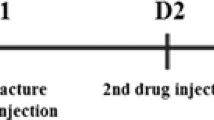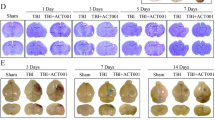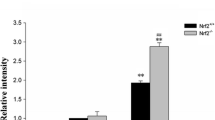Abstract
As one form of stroke, intracerebral hemorrhage (ICH) is a fatal cerebrovascular disease, which has high morbidity and mortality and lacks effective medical treatment. Increased infiltration of inflammatory cytokines coupled with pyroptotic cell death is involved in the pathophysiological process of ICH. However, little is known about whether concomitant fracture patients have the same progression of inflammation and pyroptosis. Hence, we respectively established the mouse ICH model and ICH with bilateral tibial fracture model (MI) to explore the potential cross-talk between the above two injuries. We found that MI obviously reversed the expressions of pyroptosis-associated proteins, which were remarkably up-regulated at the acute phase after ICH. Similar results were observed in neuronal expressions via double immunostaining. Furthermore, brain edema was also significantly alleviated in mice who suffered MI, when compared with ICH alone. To better clarify the potential mechanisms that mediated this cross-talk, recombinant mouse interleukin-13 (IL-13) was used to investigate its effect on pyroptosis in the mouse MI model, in which a lower level of IL-13 was observed. Remarkably, IL-13 administration re-awakened cell death, which was mirrored by the re-upregulation of pyroptosis-associated proteins and PI-positive cell counts. The results of hemorrhage volume and behavioral tests further confirmed its critical role in regulating neurological functions. Besides, the IL-13-treated MI group showed poor outcomes of fracture healing. To sum up, our research indicates that controlling the IL-13 content in the acute phase would be a promising target in influencing the outcomes of brain injury and fracture, and meanwhile, provides new evidence in repairing compound injuries in clinics.







Similar content being viewed by others
Data Availability
All data included in this study are available upon request by contact with the corresponding author.
References
Wartenberg KE, Mayer SA (2007) Reducing the risk of ICH enlargement. J Neurol Sci 261(1–2):99–107. https://doi.org/10.1016/j.jns.2007.04.044
Provencio JJ, Da Silva IR, Manno EM (2013) Intracerebral hemorrhage: new challenges and steps forward. Neurosurg Clin N Am 24(3):349–359. https://doi.org/10.1016/j.nec.2013.03.002
van Asch CJJ, Luitse MJA, Rinkel GJE, van der Tweel I, Algra A, Klijn CJM (2010) Incidence, case fatality, and functional outcome of intracerebral haemorrhage over time, according to age, sex, and ethnic origin: a systematic review and meta-analysis. Lancet Neurol 9(2):167–176. https://doi.org/10.1016/s1474-4422(09)70340-0
Qureshi AI, Mendelow AD, Hanley DF (2009) Intracerebral haemorrhage. Lancet 373(9675):1632–1644. https://doi.org/10.1016/s0140-6736(09)60371-8
Aronowski J, Zhao X (2011) Molecular pathophysiology of cerebral hemorrhage: secondary brain injury. Stroke 42(6):1781–1786. https://doi.org/10.1161/STROKEAHA.110.596718
Yuan ZC, Mo H, Guan J, He JL, Wu ZJ (2016) Risk of hip fracture following stroke, a meta-analysis of 13 cohort studies. Osteoporos Int 27(9):2673–2679. https://doi.org/10.1007/s00198-016-3603-x
Benzinger P, Rapp K, Konig HH, Bleibler F, Globas C, Beyersmann J, Jaensch A, Becker C et al (2015) Risk of osteoporotic fractures following stroke in older persons. Osteoporos Int 26(4):1341–1349. https://doi.org/10.1007/s00198-014-3005-x
Kanis J, Oden A, Johnell O (2001) Acute and long-term increase in fracture risk after hospitalization for stroke. Stroke 32(3):702–706. https://doi.org/10.1161/01.str.32.3.702
Kapral MK, Fang J, Alibhai SM, Cram P, Cheung AM, Casaubon LK, Prager M, Stamplecoski M et al (2017) Risk of fractures after stroke: results from the Ontario Stroke Registry. Neurology 88(1):57–64. https://doi.org/10.1212/wnl.0000000000003457
Kristensen J, Birn I, Mechlenburg I (2020) Fractures after stroke-A Danish register-based study of 106 001 patients. Acta Neurol Scand 141(1):47–55. https://doi.org/10.1111/ane.13172
Degos V, Maze M, Vacas S, Hirsch J, Guo Y, Shen F, Jun K, van Rooijen N et al (2013) Bone fracture exacerbates murine ischemic cerebral injury. Anesthesiology 118(6):1362–1372. https://doi.org/10.1097/ALN.0b013e31828c23f8
Li Z, Wei M, Lyu H, Huo K, Wang L, Zhang M, Su H (2020) Fracture shortly before stroke in mice leads to hippocampus inflammation and long-lasting memory dysfunction. J Cereb Blood Flow Metab 40(2):446–455. https://doi.org/10.1177/0271678X19825785
Chen G, Gao C, Yan Y, Wang T, Luo C, Zhang M, Chen X, Tao L (2020) Inhibiting ER Stress Weakens Neuronal Pyroptosis in a Mouse Acute Hemorrhagic Stroke Model. Mol Neurobiol 57(12):5324–5335. https://doi.org/10.1007/s12035-020-02097-9
Yuan B, Zhou XM, You ZQ, Xu WD, Fan JM, Chen SJ, Han YL, Wu Q et al (2020) Inhibition of AIM2 inflammasome activation alleviates GSDMD-induced pyroptosis in early brain injury after subarachnoid haemorrhage. Cell Death Dis 11(1):76. https://doi.org/10.1038/s41419-020-2248-z
Gao C, Yan Y, Chen G, Wang T, Luo C, Zhang M, Chen X, Tao L (2020) Autophagy activation represses pyroptosis through the IL-13 and JAK1/STAT1 pathways in a mouse model of moderate traumatic brain injury. ACS Chem Neurosci 11(24):4231–4239. https://doi.org/10.1021/acschemneuro.0c00517
Zhu X, Zhang K, Lu K, Shi T, Shen S, Chen X, Dong J, Gong W et al (2019) Inhibition of pyroptosis attenuates Staphylococcus aureus-induced bone injury in traumatic osteomyelitis. Ann Transl Med 7(8):170. https://doi.org/10.21037/atm.2019.03.40
Yu C, Zhang C, Kuang Z, Zheng Q (2020) The role of NLRP3 inflammasome activities in bone diseases and vascular calcification. Inflammation. https://doi.org/10.1007/s10753-020-01357-z
Kovacs SB, Miao EA (2017) Gasdermins: effectors of pyroptosis. Trends Cell Biol 27(9):673–684. https://doi.org/10.1016/j.tcb.2017.05.005
Shi J, Gao W, Shao F (2017) Pyroptosis: gasdermin-mediated programmed necrotic cell death. Trends Biochem Sci 42(4):245–254. https://doi.org/10.1016/j.tibs.2016.10.004
Zhu X, Tao L, Tejima-Mandeville E, Qiu J, Park J, Garber K, Ericsson M, Lo EH et al (2012) Plasmalemma permeability and necrotic cell death phenotypes after intracerebral hemorrhage in mice. Stroke 43(2):524–531. https://doi.org/10.1161/STROKEAHA.111.635672
Huang R, Zong X, Nadesan P, Huebner JL, Kraus VB, White JP, White PJ, Baht GS (2019) Lowering circulating apolipoprotein E levels improves aged bone fracture healing. JCI Insight 4 (18). https://doi.org/10.1172/jci.insight.129144
Wang T, Zhang L, Zhang M, Bao H, Liu W, Wang Y, Wang L, Dai D et al (2013) [Gly14]-Humanin reduces histopathology and improves functional outcome after traumatic brain injury in mice. Neuroscience 231:70–81. https://doi.org/10.1016/j.neuroscience.2012.11.019
Wang ZF, Gao C, Chen W, Gao Y, Wang HC, Meng Y, Luo CL, Zhang MY et al (2019) Salubrinal offers neuroprotection through suppressing endoplasmic reticulum stress, autophagy and apoptosis in a mouse traumatic brain injury model. Neurobiol Learn Mem 161:12–25. https://doi.org/10.1016/j.nlm.2019.03.002
Wu Y, He F, Zhang C, Zhang Q, Su X, Zhu X, Liu A, Shi W et al (2021) Melatonin alleviates titanium nanoparticles induced osteolysis via activation of butyrate/GPR109A signaling pathway. 19 (1):170. https://doi.org/10.1186/s12951-021-00915-3
Chen S, Zuo Y, Huang L, Sherchan P, Zhang J, Yu Z, Peng J, Zhang J et al (2019) The MC4 receptor agonist RO27-3225 inhibits NLRP1-dependent neuronal pyroptosis via the ASK1/JNK/p38 MAPK pathway in a mouse model of intracerebral haemorrhage. Br J Pharmacol 176(9):1341–1356. https://doi.org/10.1111/bph.14639
Sennerby U, Melhus H, Gedeborg R, Byberg L, Garmo H, Ahlbom A, Pedersen NL, Michaëlsson K (2009) Cardiovascular diseases and risk of hip fracture. JAMA 302(15):1666–1673. https://doi.org/10.1001/jama.2009.1463
Barrington J, Lemarchand E, Allan SM (2017) A brain in flame; do inflammasomes and pyroptosis influence stroke pathology? Brain Pathol 27(2):205–212. https://doi.org/10.1111/bpa.12476
Chen GY, Nunez G (2010) Sterile inflammation: sensing and reacting to damage. Nat Rev Immunol 10(12):826–837. https://doi.org/10.1038/nri2873
Fu Q, Wu J, Zhou XY, Ji MH, Mao QH, Li Q, Zong MM, Zhou ZQ et al (2019) NLRP3/Caspase-1 pathway-induced pyroptosis mediated cognitive deficits in a mouse model of sepsis-associated encephalopathy. Inflammation 42(1):306–318. https://doi.org/10.1007/s10753-018-0894-4
Dempsey C, Rubio Araiz A, Bryson KJ, Finucane O, Larkin C, Mills EL, Robertson AAB, Cooper MA et al (2017) Inhibiting the NLRP3 inflammasome with MCC950 promotes non-phlogistic clearance of amyloid-beta and cognitive function in APP/PS1 mice. Brain Behav Immun 61:306–316. https://doi.org/10.1016/j.bbi.2016.12.014
Ma Q, Chen S, Hu Q, Feng H, Zhang JH, Tang J (2014) NLRP3 inflammasome contributes to inflammation after intracerebral hemorrhage. Ann Neurol 75(2):209–219. https://doi.org/10.1002/ana.24070
Lenart N, Brough D, Denes A (2016) Inflammasomes link vascular disease with neuroinflammation and brain disorders. J Cereb Blood Flow Metab 36(10):1668–1685. https://doi.org/10.1177/0271678X16662043
Genet GF, Bentzer P, Ostrowski SR, Johansson PI (2017) Resuscitation with pooled and pathogen-reduced plasma attenuates the increase in brain water content following traumatic brain injury and hemorrhagic shock in rats. J Neurotrauma 34(5):1054–1062. https://doi.org/10.1089/neu.2016.4574
Yang X, Tang X, Sun P, Shi Y, Liu K, Hassan SH, Stetler RA, Chen J et al (2017) MicroRNA-15a/16-1 antagomir ameliorates ischemic brain injury in experimental stroke. Stroke 48(7):1941–1947. https://doi.org/10.1161/STROKEAHA.117.017284
Wang L, Kang S, Zou D, Zhan L, Li Z, Zhu W, Su H (2016) Bone fracture pre-ischemic stroke exacerbates ischemic cerebral injury in mice. PLoS One 11(4):e0153835. https://doi.org/10.1371/journal.pone.0153835
Jeong JY, Chung YC, Jin BK (2019) Interleukin-4 and interleukin-13 exacerbate neurotoxicity of prothrombin kringle-2 in cortex in vivo via oxidative stress. Int J Mol Sci 20 (8). https://doi.org/10.3390/ijms20081927
Cardilo-Reis L, Gruber S, Schreier SM, Drechsler M, Papac-Milicevic N, Weber C, Wagner O, Stangl H et al (2012) Interleukin-13 protects from atherosclerosis and modulates plaque composition by skewing the macrophage phenotype. EMBO Mol Med 4(10):1072–1086. https://doi.org/10.1002/emmm.201201374
Kolosowska N, Keuters MH, Wojciechowski S, Keksa-Goldsteine V, Laine M, Malm T, Goldsteins G, Koistinaho J et al (2019) Peripheral administration of IL-13 induces anti-inflammatory microglial/macrophage responses and provides neuroprotection in ischemic stroke. Neurotherapeutics 16(4):1304–1319. https://doi.org/10.1007/s13311-019-00761-0
Shin WH, Lee DY, Park KW, Kim SU, Yang MS, Joe EH, Jin BK (2004) Microglia expressing interleukin-13 undergo cell death and contribute to neuronal survival in vivo. Glia 46(2):142–152. https://doi.org/10.1002/glia.10357
Nam JH, Park KW, Park ES, Lee YB, Lee HG, Baik HH, Kim YS, Maeng S et al (2012) Interleukin-13/-4-induced oxidative stress contributes to death of hippocampal neurons in abeta1-42-treated hippocampus in vivo. Antioxid Redox Signal 16(12):1369–1383. https://doi.org/10.1089/ars.2011.4175
Park KW, Baik HH, Jin BK (2009) IL-13-induced oxidative stress via microglial NADPH oxidase contributes to death of hippocampal neurons in vivo. J Immunol 183(7):4666–4674. https://doi.org/10.4049/jimmunol.0803392
Mollahosseini M, Ahmadirad H, Goujani R, Khorramdelazad H (2021) The association between traumatic brain injury and accelerated fracture healing: a study on the effects of growth factors and cytokines. J Mol Neurosci 71(1):162–168. https://doi.org/10.1007/s12031-020-01640-6
Newman RJ, Stone MH, Mukherjee SK (1987) Accelerated fracture union in association with severe head injury. Injury 18(4):241–246. https://doi.org/10.1016/0020-1383(87)90006-4
Pollard JW (2009) Trophic macrophages in development and disease. Nat Rev Immunol 9(4):259–270. https://doi.org/10.1038/nri2528
Scopes J, Massey HM, Ebrahim H, Horton MA, Flanagan AM (2001) Interleukin-4 and interleukin-13: bidirectional effects on human osteoclast formation. Bone 29(3):203–208. https://doi.org/10.1016/s8756-3282(01)00500-2
Funding
This research was supported by the Natural Science Foundation of China (Grant Number: 81971800, 81871536, 82072110, and 82101452), and a Project Funded by the Priority Academic Program Development of Jiangsu Higher Education Institutions (PAPD).
Author information
Authors and Affiliations
Contributions
Y.Y., C.G., and G.C. contributed equally to this paper. L.T., X.C., and J.L. comprehended the study, provided critical suggestions, contributed to manuscript preparation, oversaw the research program, and wrote the main manuscript. Y.Y., C.G., and G.C. performed the Western blot and immunostaining experiments and analyzed the data. Y.Y., C.G., G.C., X.C., H.X., Z.C., C.L., M.Z., and T.W. performed the brain edema test, PI staining, bleeding volume test, ELISA test, behavioral experiment, and analyzed the data. Y.W. performed tibial fracture surgery, micro-CT scan, and analyzed the data. All the authors listed in the manuscript have agreed upon and reviewed the manuscript and provided feedback.
Corresponding authors
Ethics declarations
Ethics Approval
All animal procedures were approved by the Institutional Animal Use and Care Committee at Soochow University and carried out in accordance with the guidelines of Animal Use and Care of the National Institutes of Health (NIH) and the Animal Research: Reporting in Vivo Experiments (ARRIVE).
Consent to Participate
Informed consent was obtained from all individual participants included in the study.
Consent for Publication
All the authors consent for the publication of this manuscript.
Competing Interest
The authors declare no competing interests.
Additional information
Publisher’s Note
Springer Nature remains neutral with regard to jurisdictional claims in published maps and institutional affiliations.
Supplementary Information
Below is the link to the electronic supplementary material.
Rights and permissions
About this article
Cite this article
Yan, Y., Gao, C., Chen, G. et al. Interleukin-13 Affects the Recovery Processes in a Mouse Model of Hemorrhagic Stroke with Bilateral Tibial Fracture. Mol Neurobiol 59, 3040–3051 (2022). https://doi.org/10.1007/s12035-021-02650-0
Received:
Accepted:
Published:
Issue Date:
DOI: https://doi.org/10.1007/s12035-021-02650-0




